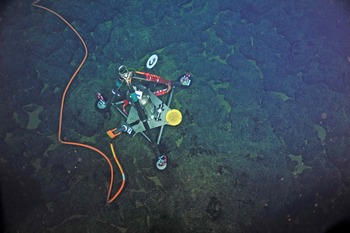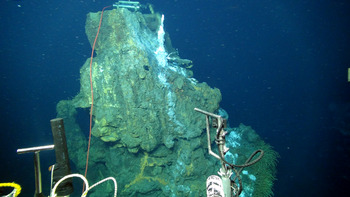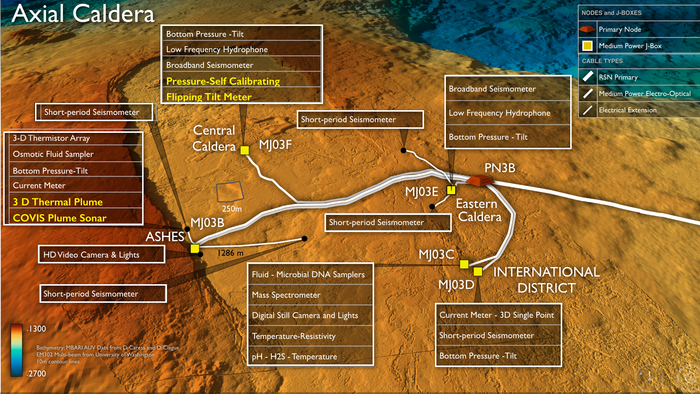
A bottom pressure tilt instrument is installed at the Eastern Caldera Site on the summit of Axial Seamount. Image Credit: VISIONS'13, NSF-OOI/UW/CSSF; Dive R1617; V13

A temperature-resistivity sensor, with its wand now embedded in a sulfate-rich chimney (white, right) sends real-time data to shore from the Escargot chimney, 5000 ft beneath the oceans' surface and >300 miles offshore. Resistivity is an analogue for fluid chlorinity. Numerous hydrothermal vents in the International District Hydrothermal Field at the summit of Axial Seamount are boiling. Credit. UW/OOI-NSF/WHOI; Dive J2-912, V16.
Location: 46.1ºN 130.0ºW Water Depth: 1510-1530 meters
Axial Seamount on the Juan de Fuca spreading center is an optimal site for a long-term observatory. It is located just one day by ship from the Washington and Oregon coasts. It is the most magmatically robust volcano on the spreading center, having erupted in 1998, 2011, and again April 24, 2015. It hosts numerous active hydrothermal fields and abundant sites of diffuse flow (Kelley et al., 2014). It is the most advanced volcanic observatory in the worlds' oceans.
On August 8, 2014, all secondary infrastructure (cables, junction boxes and instruments) were connected to Primary Node PN3B. The node provides power and communication to five Medium Power J-Boxes that allow access to the ASHES and International District hydrothermal vent fields and to the Central and Eastern Caldera Site. Real-time high definition video streaming to shore provides unprecedented views of macrofaunal and microbial communities at the vents. Chemical sensors and thermistor arrays are providing real-time information on the environmental conditions in which the biological communities thrive. The instrumentation will also new insights on the impact of flow perturbations associated with eruptive and seismic events on biological communities. Other sensors now installed include an situ mass spectrometer for fluid – volatile chemistry, broadband and short-period seismometers to monitor earthquake and magma migration activity, temperature and chemical probes in diffuse and black smoker sites, fluid and DNA samplers. The in situ DNA sampler is initially focused on in-situ filtering and preservation of time series samples in the TIny Towers diffuse flow site, coupled to the mass spectrometer and fluid sampler. A digital still camera provides time-series imagery of the the site.
The broadband and short-period seismometers detected >8000 earthquakes marking the start of the April 24, 2015 eruption and real-time data from bottom pressure-tilt meters documented the ~2.4 m collapse of the volcanoes caldera in 24 hrs during this same period: over 30,000 explosive events were detected with the Cabled Array hydrophones.
The instrument array at Axial, now fully installed, is the largest single in situ experiment in the global ocean focused on long-term measurements of underwater volcanoes with transmission of real-time data and imagery back to shore. Seismic data are now available through IRIS, live inflation and deflation plots provided by W. Chadwick at OSU-NOAA-PMEL hint that the volcano may erupt in 2020-2021, and the volcano is now seismically active with >600 earthquakes measured in one day in April, 2018. Other instrument data is available through the OOI Data Portal.
New instruments to be added this year include three instruments funded by the National Science Foundation - two instruments to measure seafloor deformation (awards to W. Wilcock, Univeristy of Washington and G. Sasagawa and M. Zumberge, SIO-UCSD), a sonar at the ASHES vent field to image hydrothermal plumes and diffuse flow (K. Bemis, Rutgers University). A


